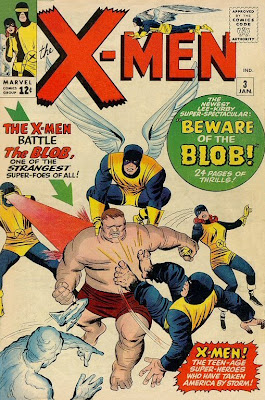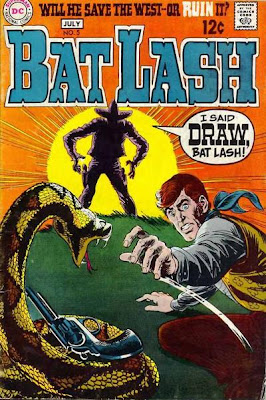
FANTASTIC FOUR #22
Finally—finally—finally. With a little help from Reed, Sue finally figures out that she can generate invisible force fields, as well as turn other things invisible. Though Lee and Kirby had been doing a pretty good job of giving Sue useful ways to use her invisibility, this upgrade to her power is long-overdue and more than welcome.
And just in time, as well. In a series of hilarious scenes, the FF start getting a barrage of complaints from fellow tenants in the Baxter Building about noise, Reed’s potentially dangerous experiments and the presence of stuff like an ICBM rocket on the premises. (Actually, that last complaint is kinda understandable.) Frustrated, Reed decides to look into buying a small island off the coast of New Jersey on which to house the large vehicles and conduct his more dangerous experiments. But it’s all a trap, of course—the FF’s very first enemy has returned to try to do them in.
The Mole Man’s whole plan includes building giant hydraulic lifts beneath New York and Moscow. He’ll lower both cities beneath the Earth’s surface, getting the U.S. and the Russians to blame each other. The ensuing nuclear war will dispose of all us annoying surface-dwellers. And, of course, he’ll have the Fantastic Four prisoner on that island, forcing them to watch the whole thing.
The FF foils his plans, of course. Sue’s new powers, not surprisingly, prove vital. And there’s a repeat of a theme used way back in FF #2, in which each of the four is locked in a separate cell and must use their powers in clever ways to escape. It is all typically good Kirby action choreography.
The plot’s a bit unlikely—in a comic book universe, lowering a city on giant hydraulic lifts in perfectly acceptable. But it seems that—if Mole Man can do that—there must be less complicated and more straightforward ways to destroy the cities and incite nuclear holocaust. And how the heck did Mole Man arrange for all those people to simultaneously begin complaining to the FF? I actually have more of a problem with that detail than with the whole giant hydraulic lift thing.
Oh, well. Rationally, I realize that the plot holes are probably no more obvious than in other issues I’ve praised. But this time around, they just seemed to stand out a little more glaringly.
Plot holes aside, though, it’s amping up Sue’s power that makes this issue a truly important one.

SPIDER MAN #8
They say public schools have become dangerous places in recent years, but—judging from Spider Man comics—they weren’t all that safe in 1964 either. Just a few months after Spidey had a running fight with Sandman through the halls of his high school, the webslinger now has a running fight through those same halls with an out-of-control giant robot.
It’s a pretty good fight, though the robot’s design is kinda clunky and uninteresting. But the real treats of this issue come from the sub-plots. School bully Flash Thompson gives Peter Parker an unfriendly shove. This results in Peter’s glasses getting broken. He never does bother to replace them—I’ve always wondered if maybe Steve Ditko just got tired of having to draw them. (In fact, now that I've typed that, I have some vague--but very uncertain--memory of having once read that somewhere.)
Anyway, Pete gets ticked off enough to agree to take Flash on in the boxing ring. Everyone’s cheering for Flash, of course, but he can’t seem to lay a glove on Peter. Peter, belated concerned about his secret identity, tries to pull his own punches but inadvertently knocks Flash out of the ring. The other students merely assume that Flash is joking around and pretty much shove him back into the ring.
Fortunately, the fight is interrupted by that out-of-control robot. Peter ends what turns out to be a good day by managing to start a rumor that Flash is actually Spider Man.
There’s a short back-up story as well, in which Spider Man crashes a party being attending by the Human Torch—pretty much just because he wants to get on the Torch’s nerves. These leads to a brief fight between the two. The rest of the Fantastic Four show up and Spidey, who jumps to the conclusion that he’s being laughed at, tries to take them all on. Sue calms things down by telling Spidey she thinks he’s probably cute under his mask. Stan Lee really seems to be making a point to build up the Spidey/Torch feud over the last few months. But it’s been a very entertaining feud so far, so that’s not a bad thing at all. Undoubtedly, Stan realized how much humor could be consistently milked from the situation.

STRANGE TALES #116
The Puppet Master returns to take his vengeance upon the Fantastic Four. I love his plan—he makes a puppet of Johnny and uses this to force Johnny to make a play for Alicia Masters. This, naturally, ticks off Ben and the two start fighting.
Alicia calls the Baxter Building for help, but Sue and Reed ignore the ringing phone because they’re going out on a date for the first time in weeks. So the poor blind girl has to take action on her own, eventually managing to direct the Torch to drop a flaming sheet from the sky at the right moment to burn up the Johnny puppet.
I guess I’m in a “find the plot hole” mode this month, but at one point, the Puppet Master orders Johnny to fly head first into a jet plane. Johnny, because he’s flamed on, is able to fly THROUGH the jet and POP OUT its rear exhaust. I’m not sure I’m okay with that (though I’m still okay with the giant city-sized hydraulic lifts from this month’s FF. Go figure.) And the ending, with BLIND Alicia pretty much choreographing Johnny’s actions with exacting precision, was also a tad bit contrived.
But the Ben/Johnny fight was a good one and some dialogue about how their friendship kept them from really hurting each other was a nice, if a little corny, bit of characterization.
Meanwhile, Dr. Strange is having trouble with Nightmare again, who is kidnapping humans into his realm while they sleep. The good doctor has to enter the Nightmare realm to save them.
This is the sort of thing Steve Ditko excelled at in this series. The designs for the extra-dimensional setting of the battle, as well as the design for Nightmare and some of the creepy monsters he controls, are just wonderful. The ending is a little abrupt, but it is overall a solid and visually powerful story.
Next week, we’ll take a look at Thor, Iron Man and Giant Man.



















